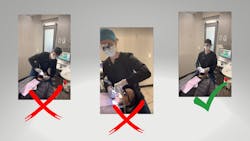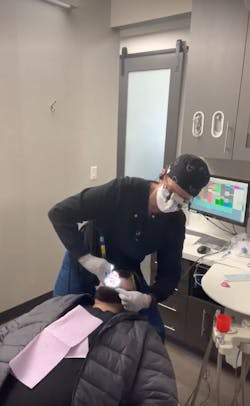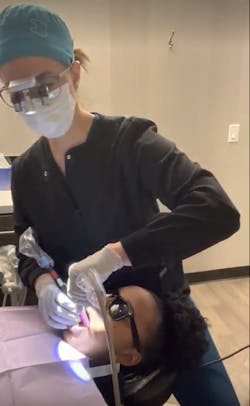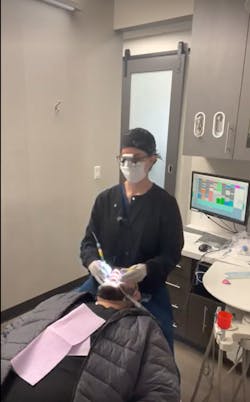Why you need to be using a suctioning device
With the many tasks involved with caring for patients and trying to keep them comfortable, it can be easy to put ergonomics on the back burner. However, without proper ergonomics and body awareness, bodies will quickly develop pain, fatigue, and eventual injury. Up to 91% of dental hygienists report either having had or currently having a musculoskeletal disorder (MSD).1 MSDs wreak havoc on dental professionals’ lives, affecting not only their work but also their home life, mental health, and relationships.
Due to the intense nature of our work, we must use simple, easy-to-incorporate ergonomic tools to help us. Among many such ergonomic interventions is suction devices.
Why not using a suctioning device is a problem
I perform ergonomic assessments for all dental clinicians, and one issue I frequently see with hygienists is that they don’t use a device for suctioning. They hold the suction in one hand while using their power scaler in the other (Figure 1).
There are several reasons that this is problematic. For one, hygienists who do this can’t use their mirror, and using indirect vision is crucial to maintain good posture and visualization. In some areas, we can get away with using direct vision and still be able to have good posture. However, if a right-handed hygienist tries to scale and visualize the upper right lingual surfaces without a mirror, their posture will fall apart quickly.
You might also be interested in: What I wish I knew before purchasing loupes
Holding the suction is also a problem in terms of how much force we use when gripping it. Excessive grip or pinch force causes our forearm muscles to work way too hard, leading to pain and fatigue. As well, when the forearm muscles get tight, they pull on the tendons in our wrists and elbows.2 This increases the risk of MSDs such as wrist or elbow tendonitis or carpal tunnel syndrome. Excessive pinch force can even have effects up to our shoulder and neck. When holding the suction, we’re also typically trying to retract a strong cheek or tongue, which further increases our force.
Another reason holding the suction is an issue is that it creates an inability to rest the nondominant hand. Just picture it: holding the suction for 20 minutes straight while using excessive force, the arm abducted away from the body (chicken-wing), and not giving it time to rest (Figure 2).
We must rest our muscles periodically during the appointment to increase blood flow. When we’re in a fixed, awkward position for extended periods, pressure builds up on the inside of that muscle, cutting off blood flow. Blood carries oxygen and nutrients and removes waste products from the muscles. So, if we have muscles under incredible strain and they don’t get the nutrition they need, they will start to fail. We will feel pain, fatigue, and eventual injury. For the sake of our health, we need to perform regular microbreaks where we deliberately rest the muscle, allowing blood flow to reach the muscle and heal damage.
With the simple addition of a suction device, you can use your mirror, keep your patient comfortable, and have much better ergonomics (Figure 3). You’ll feel the difference, and it will reduce your risk of an MSD.
Choosing the right suction device
There are many options to choose from. The first aspect to decide is whether you’re concerned about aerosols. Some suction devices help control aerosols, while others do not. Once you decide, consider whether you want one that uses the saliva ejector or the HVE.
Another factor to consider is the weight of the cord for both the saliva ejector and the HVE. If you have been holding either one, you know how the weight pulls on you over time. This same weight will pull on the patient, depending on your device. There are lightweight cords that will dramatically reduce the weight for both you and your patient.
There are simple devices that attach directly to the saliva ejector and are very easy to incorporate into your appointment. Some devices will attach to the HVE; some control aerosols, some don’t. Be sure to check the manufacturers’ specifications to determine if they control aerosols. Mostly, these devices “plug” into the side of the patient’s mouth and provide comfortable suction with minimal adjustment. These are easily adapted to each side of the mouth. Your choice will depend on your personal preference and your desire to control aerosols (or not).
Thinking about ergonomics can sometimes be overwhelming since we have many other things to consider during an appointment. Incorporating a suction device is an easy way to improve your ergonomics, reduce pain and fatigue, and decrease your risk of developing an MSD over time.
Editor's note: This article appeared in the July 2023 print edition of RDH magazine. Dental hygienists in North America are eligible for a complimentary print subscription. Sign up here.
References
1. Saccucci M, Zumbo G, Mercuri P, Pranno N, Sotero S, Zara F, Vozza I. Musculoskeletal disorders related to dental hygienist profession. Int J Dent Hyg. 2022;20(3):571-579. doi:10.1111/idh.12596
2. Buchanan BK, Varacallo M. Tennis Elbow. In: StatPearls [Internet]. StatPearls Publishing; 2022.
About the Author
Stephanie Botts, BSDH, RDH, CEAS
Stephanie Botts, BSDH, RDH, CEAS, has been a clinical dental hygienist for over 17 years. She is a certified ergonomics assessment specialist providing both in-office and virtual ergonomics consulting and coaching to dental professionals. She also provides CE to dental and dental hygiene associations on ergonomics. Stephanie believes that by learning effective strategies to optimize proper ergonomics, dental professionals can practice pain-free and ensure career longevity. She can be reached at [email protected] or on Instagram at @steph.polishedposture.




